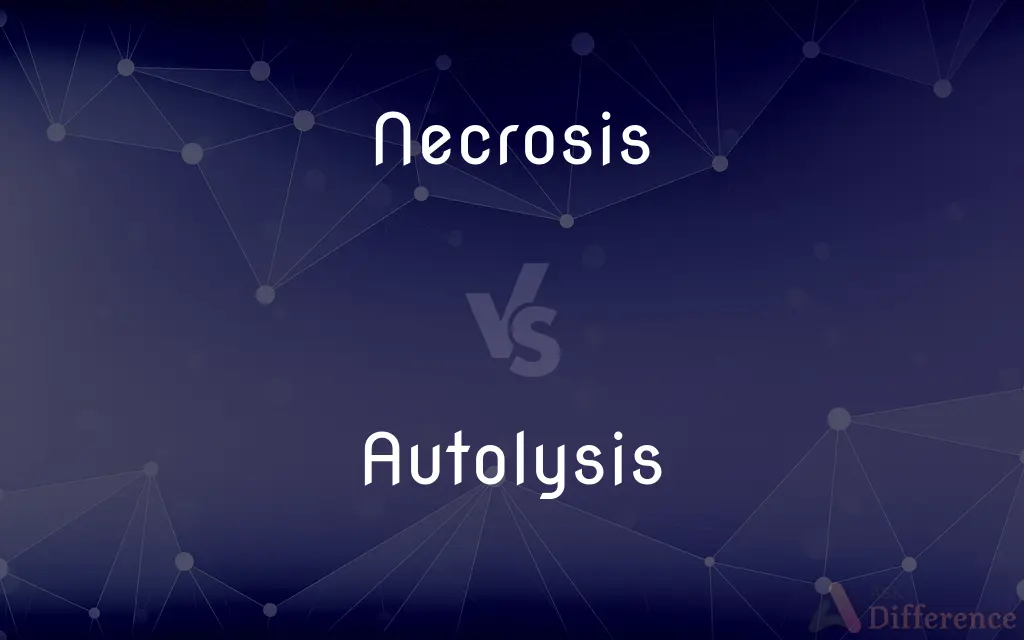Necrosis vs. Autolysis — What's the Difference?
By Urooj Arif & Fiza Rafique — Updated on April 1, 2024
Necrosis is cell death caused by external factors like toxins or trauma, while autolysis is self-digestion of cells after death.

Difference Between Necrosis and Autolysis
Table of Contents
ADVERTISEMENT
Key Differences
Necrosis is a form of cell death resulting from external damage or lack of blood supply, leading to inflammation. Whereas autolysis occurs when cells self-destruct using their own enzymes after death, usually without causing inflammation.
In necrosis, the cell membrane integrity is compromised, causing the cell contents to leak out and potentially harm surrounding tissues. On the other hand, autolysis is more contained, as it involves the breakdown of cells by their own enzymes from within, typically not affecting neighboring cells.
Necrosis is often associated with pathological conditions such as infections, toxins, or trauma. Conversely, autolysis can be considered a natural part of the dying process, happening after death in tissues and organs.
The process of necrosis is generally considered to be uncontrolled and chaotic, causing damage to nearby tissues and eliciting an immune response. Autolysis, however, is a more orderly process that begins after cellular death and does not typically provoke an immune response.
While necrosis can lead to significant tissue damage and disease, autolysis is often involved in the post-mortem breakdown of cells, making it a critical process in the decomposition of organisms.
ADVERTISEMENT
Comparison Chart
Definition
Cell death due to external factors.
Self-digestion of cells after death.
Cause
Infections, toxins, trauma.
Endogenous enzymes.
Impact
Causes inflammation and tissue damage.
Typically contained within the cell.
Process
Uncontrolled and chaotic.
Orderly and self-contained.
Immune Response
Often triggers an immune response.
Does not typically provoke an immune response.
Compare with Definitions
Necrosis
Involves cell swelling and rupture.
Under the microscope, necrosis was evident by the swollen cell bodies.
Autolysis
Occurs after death.
The pathologist noted autolysis in the sample, a common post-mortem change.
Necrosis
Cell death from injury or disease.
The necrosis in his liver was caused by prolonged exposure to toxins.
Autolysis
Self-digestion by cellular enzymes.
Autolysis began soon after the organism's death, breaking down cells.
Necrosis
Can lead to inflammation.
The area of necrosis quickly became inflamed, indicating immune system activity.
Autolysis
Involves lysosomal enzymes.
Lysosomal enzymes are key agents in the process of autolysis.
Necrosis
Affects groups of cells.
Necrosis affected entire regions of the tissue, not just individual cells.
Autolysis
No inflammation involved.
Unlike necrosis, autolysis does not cause an inflammatory response.
Necrosis
Often results from lack of blood supply.
The necrotic tissue was primarily due to a blocked artery.
Autolysis
Part of decomposition.
Autolysis is a crucial step in the decomposition of biological tissues.
Necrosis
Necrosis (from Ancient Greek νέκρωσις, nékrōsis, "death") is a form of cell injury which results in the premature death of cells in living tissue by autolysis. Necrosis is caused by factors external to the cell or tissue, such as infection, or trauma which result in the unregulated digestion of cell components.
Autolysis
The breaking down of cells or tissues by their own enzymes. Also called self-digestion.
Necrosis
Death of cells through injury or disease, especially in a localized area of a tissue or organ.
Autolysis
The destruction of an organism's cells by enzymes produced by the organism itself.
Necrosis
(pathology) The localized death of cells or tissues through injury, disease, or the interruption of blood supply.
Autolysis
(pathology) The autodigestion of the tissues of an organism.
Necrosis
The pathologic death of part of a tissue due to irreversible damage. Contrast to necrobiosis, which is a normal death of cells in a tissue. Formerly, applied primarily to death of bone tissue.
Autolysis
(pathology) The autocytolysis of blood cells.
Necrosis
A disease of trees, in which the branches gradually dry up from the bark to the center.
Autolysis
(wine) The decomposition of dead yeast cells in wine after fermentation.
Necrosis
The localized death of living cells (as from infection or the interruption of blood supply)
Autolysis
(baking) A two-stage mixing process where water and flour are combined first before adding leavening and salt.
Autolysis
Lysis of cells or tissues due to enzymatic activity from within the cell, as contrasted with externally induced lysis.
Autolysis
Lysis (self-digestion) of tissues when they are detached from the organism
Common Curiosities
What triggers necrosis?
Necrosis is triggered by external factors such as toxins, infections, or physical trauma.
Is autolysis a type of cell death?
Yes, autolysis is a type of cell death characterized by self-digestion through cellular enzymes.
How does necrosis affect surrounding tissues?
Necrosis can cause damage to surrounding tissues by releasing toxic cell contents and triggering inflammation.
What is the primary difference between necrosis and autolysis?
The primary difference is the cause; necrosis is due to external factors, while autolysis is self-initiated after death.
Why is necrosis considered harmful?
Necrosis can be harmful because it damages tissues and elicits an inflammatory immune response.
What role do enzymes play in autolysis?
Enzymes, especially lysosomal enzymes, play a key role in breaking down cell components during autolysis.
Can autolysis occur in living organisms?
Autolysis typically occurs after the death of an organism, not in living cells.
How can necrosis be identified?
Necrosis can be identified by cell swelling, rupture, and subsequent inflammation in the affected area.
How does the body respond to necrotic tissue?
The body often responds to necrotic tissue with inflammation and by attempting to remove the dead cells.
Is autolysis always a bad sign?
Not necessarily; autolysis is a natural part of cell turnover and decomposition after death.
Does autolysis lead to inflammation?
No, autolysis typically does not lead to inflammation since it occurs after cell death.
What are the pathological implications of necrosis?
Necrosis can lead to various pathological conditions, including infections and diseases, due to tissue damage.
Can necrosis be reversed?
Once cells have undergone necrosis, they cannot be revived, but its progression can sometimes be halted.
What is the significance of autolysis in medical studies?
Autolysis is significant in medical studies for understanding post-mortem changes and the natural decomposition process.
Is autolysis a controlled process?
Yes, autolysis is a more controlled and orderly process than necrosis, though it happens post-mortem.
Share Your Discovery

Previous Comparison
Fast vs. Slow
Next Comparison
Millie vs. MillyAuthor Spotlight
Written by
Urooj ArifUrooj is a skilled content writer at Ask Difference, known for her exceptional ability to simplify complex topics into engaging and informative content. With a passion for research and a flair for clear, concise writing, she consistently delivers articles that resonate with our diverse audience.
Co-written by
Fiza RafiqueFiza Rafique is a skilled content writer at AskDifference.com, where she meticulously refines and enhances written pieces. Drawing from her vast editorial expertise, Fiza ensures clarity, accuracy, and precision in every article. Passionate about language, she continually seeks to elevate the quality of content for readers worldwide.














































